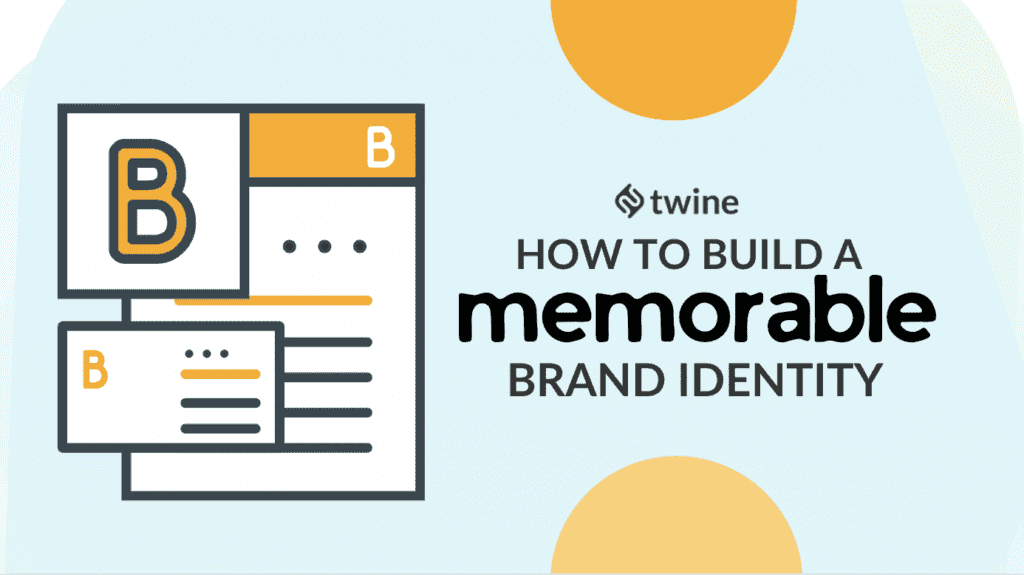
Brand identity is the hood ornament of your business.
Wherever your brand goes, wherever it has a presence, it’s your brand identity that’s seen and heard first. Your brand identity says who you are, what you stand for, and makes the statement of why you should be paid the attention you deserve. Furthermore, brand identity is the foundation of customer loyalty.
That’s important because 36.5% of shoppers say they spend more with brands they’re loyal to.
While building a memorable brand identity isn’t as straightforward as creating a logo and a catchy tagline, it can be an enjoyable and creative process.
But don’t let that ‘fun’ creativity take over – there are specific roles that your brand identity needs to fulfil if it’s going to create brand loyalty successfully.
In this article, you’ll see how to build a memorable brand experience, as well as:
- Why brand identity is important
- The role of social media
- Examples & what not to do
Let’s dive in.
Why strong brand identity is important
In essence, your brand identity is what people think of your brand when they’re not interacting with it. Your brand identity is the impression that’s left of their mind. It’s the face of your business.
Your brand identity and brand image are different but similar – they are the summation of how your brand is perceived.
Below, you can see how Swedish leisure-wear brand Brahmaki’s identity quickly creates one of relaxed elegance.
A solid and memorable brand identity is vital, not just because it’s how your brand is remembered.
- Brand identity helps consumers emotionally connect and invest in your brand
- Identity makes a statement and helps you distinguish yourself from competitors
- Identity enables you to build trust and rapport with both new and existing customers
Incorporated into your brand’s image is its values, principles, your Modus Operandi – the reason you do what you do. From these aspects, you can extrapolate your visual identity, tone of voice and many other things. Once all this is established, you will have built a solid foundation for your brand.
German streetwear brand Stay Cold have nailed their tattoo-inspired visual identity.
Their values are reflected in their products, but also their marketing material, their branding, their product photos and much more.
Before you go too far in developing the way your brand is perceived, you must get to know who will be buying your product or service as best you can.
Researching your audience personas
Without defining audience personas, you may as well stand from the tallest building in town and scream your brand’s name.
You’ll reach many people, but none of it will convert into money in the bank.
Defining and researching your audience personas and then segmenting the market will help you narrow down who you’re talking to and help you speak to them directly.
In doing this, you can easily position your brand as understood by and relatable to your target audience.
What do your customers want?
Are they price-sensitive, or are they willing to spend extra money on something that will solve a problem?
If your consumers are price-sensitive, your branding may be less critical, as consumers just want a reliable product at the lowest possible price.
If you don’t want to compete on price, your branding will build trust and add value. It’s not just affordable; it’s the best value for money.
Is your product purchased and consumed in bulk, or is it bought only a few times a year?
If your product is sold in high volumes, its quality often becomes more important than the brand selling it.
On the other hand, products that aren’t brought frequently may mean that the consumer spends more time researching and assessing where the product comes from and who’s responsible for it. Cosmetics are a fine example of such a product.
All of these above concepts will affect how you present your brand to the consumer. To be most effective, your brand identity needs to be tailored around what the customer is looking for and how your product solves the customer’s problem.
Once you’ve found a way to put your values and unique selling points into your visual identity, you’ll be well on your way to creating a visual identity.
Visual identity
How does your brand look?
Is it loud, bold, bright and in your face like Mochila?
Is it rugged, durable and tough like Cat Workwear?
Is it modern, slick and understated like M0ther?
It is high-end, opulent and elegant like Norlan glass?
Which one resonates with your audience persona the most?
Each one of those styles mentioned above invokes different visual queues and aesthetic motifs. Colour psychology plays a big part in visual identity, so it’s vital to use the right colour pallet.
Shapes also play a prominent role in your visual identity. Keep in mind that this will also impact the way you design your branded merchandise, which will further help you disseminate your brand and build customer loyalty in the long run.
Below is a fine example of blending colour psychology and shapes. Chasin’ Unicorns is a self-care subscription box. Notice the use of calming purples and blues.
The brand’s logo takes on a sharp geometric shape, just like the crystals that are the subscription box’s centrepiece.
Logos, taglines & brand identity
What brand is this?
Similarly, you probably even know this brand’s tagline by heart.
You know these things because Nike is a fine example of a strong logo and a memorable slogan.
For a business like yours, a memorable logo and catchy taglines lead the way. These elements are most likely to be remembered by your brand, and it’s what will keep customers returning to you time and time again.
Robust logo design is vital. While logo design is easy enough to do by yourself, good logo design isn’t so easy. Freelance designers who specialise in logo design can help make creative decisions and steer your logo design in the right direction.
Below you can see how Italian clothing brand Anthem echoes their logo design on several physical pieces, including their clothing tags, mailing bags, and thank you notes.
An alternative is the development of a brand ‘mascot’. IT outsourcing provider K&C recently decided to freshen up a brand image it felt had become a little conservative and old-fashioned. A new generation of IT managers and decision-makers were becoming its typical audience persona and a traditional B2B service provider felt the company’s branding didn’t fit.
The decision was made to introduce a cartoon mascot designed to reflect the company’s new strategic positioning as a fresh-faced and modern technology solutions partner for the increasingly fresh-faced and modern companies it now serves. Doing so immediately changed how the brand was perceived in the context of the increasingly important emphasis on culturally fit innovative digital-first companies expect of their strategic partners.
A new tagline designed to build trust and start a transparent, honest conversion with prospective new partners was also introduced to compliment the mascot.
When it comes to taglines, an experienced copywriter can be a source of inspiration if you lack it.
When using creative freelancers, you must provide them with the most information possible about your business. Giving an external contributor a brief of some kind is essential. Still, you’ll get a better result if you provide your mission statement, values, morals and generally state your brands ‘why’. An experienced freelancer can then take these elements and reflect them in a logo, tagline, or just about anything else.
Even though it’s not consumed via the eyes, your brand’s tone of voice works closely with your visual identity.
Tone of voice
The tone of voice is the way your brand uses words and copy to communicate. The personality that’s put into your copy plays a significant role in building a memorable brand identity. The words you choose to use say a lot about what is and what it is not. Your tone of voice almost turns your brand into a physical person that a reader is conversing with.
Is your brand imaginative and creative? Is it traditional and conservative? Perhaps it’s fun and risque.
Malimo knows that their products are often gifted, so they use clever copy on their packaging design to build the anticipation of opening a gift.
Bringing tone of voice in line with the rest of your brand identity helps you create a consistent brand experience, as it creates a complete image of your brand.
In the end, your brand has an image that can go on to foster customer loyalty and brand advocates.
How social media can impact your brand identity
Social media is just one of many channels where you can apply your brand identity. It’s one of the best channels to do so because it works two ways. You engage with followers, and they can engage with you.
When done well, your brand identity itself can be worth marketing.
Wendy’s Twitter account is a fine example of a brand identity that sells itself.
Savor the moment. The best roasts of #NationalRoastDay 2021 are right here. https://t.co/naLA8BFQrw
— Wendy’s (@Wendys) February 12, 2021
The account is so well known for its outspoken tweets that people seek it out, thus opening the brand Wendy’s up to more people.
However, not every social media platform is suited for the same tone of voice. Wendy’s Twitter marketing wouldn’t take well to LinkedIn, a platform that’s much more professional.
The best social media platforms for you to use depending on your target market. If you’re an apparel brand, you might get a lot of traffic from LinkedIn. Pinterest, on the other hand, may bring a lot of traffic, but none that converts. Marketing automation software can help you stay sane when posting content to multiple social media platforms.
You must do your research and find out what works for your brand, as well as your audience. Social monitoring is a great way to monitor trends relevant to your brand to help further fine-tune your brand identity. It’s also useful to monitor mentions of products and competitors.
One often overlooked part of brand identity, and social media marketing uses it as a customer service channel. Nearly 70% of consumers look to a brand’s social media profiles for customer support.
Building quality customer support, as part of a brand identity, is a science. Ticketing system software can help you connect communications with customers across various social networks. This way, you can be sure that you will not miss any message from a customer.
When developing a customer support strategy around social media, your identity mustn’t get in the way of helping your customers solve their problems.
If your brand is small or creating its first social media campaign, consider using the skill of experienced freelancers. You’ll be able to get the valuable insights of skilled individuals without long-term commitments.
What to avoid when building your brand identity
You’ve just had an in-depth look at what to do when building a brand identity. But for everything that you should do, there are just as many things that you shouldn’t do. Here are a few things to avoid when establishing your brand’s identity.
Copying competitors
You must know who your competitors are. It’s also highly advantageous to know what’s working for them. But it’s pretty easy to go too far when trying to replicate their success.
Copying what your competitors are doing down to a T isn’t going to help you win loyal customers. Having noticeable differences between you and your competitors in all business areas helps you create your own space for your brand to thrive and grow.
Your product may very well be a carbon copy of your competitors, but that doesn’t mean your brand identity has to be. Whether your product is the same, slightly different or miles away from that of your competitors, unique branding will help you stand out.
Being too emotionally attached to ideas
Emotion in business is one thing – we use our humanity to make the best decisions for our businesses each and every day. But being too attached to an idea, especially when it comes to branding, may hold you back.
You may have a fantastic idea for a clothing brand, but be 100% committed to using your kid’s drawing of a cat as your logo. You might be hell-bent on using your childhood sports club colours as your colour palette. But the truth is, these are the best decisions for you as a person, not your brand.
Not using data
Data doesn’t lie.
Use your social media posts as an indication of the values of your followers – if an ‘edgy’ social media post resulted in some lost followers, don’t repeat it. A/B testing is a great way to test visual assets on your site.
Test several different types of product photography to see which ones get the most interaction and result in the most conversions.
A/B testing allows you to figure out what works and what doesn’t – just make sure you aren’t testing too much simultaneously.
Being too safe
If you want something no one’s ever had, you need to be prepared to do things no one’s ever done.
Your business won’t dominate your niche or shake up the industry if it’s doing the same thing that everyone else has done. This means avoiding cliche logo designs, but also trying a new business model, like a subscription box or D2C. Similarly, avoiding cliches of your industry is important.
Take Crystal Body Drip, for example. They’re a CBD brand, but their branding has nothing to do with a 7-pointed leaf or the colour green.
Simple black and white branding and a unique font complement each other. The brand stands out from the plethora of different CBD oil brands by taking a risk – black and white minimalist branding.
Conclusion
Branding identity is everything to your brand. It helps define who you are, allows you to stand out, but most importantly, helps you create a long-term brand that’ll stand the test of time.
Creating your brand identity is a fun and important step in establishing a business. There are certain requirements that will influence what your brand becomes, but also remember to enjoy the creative process!




